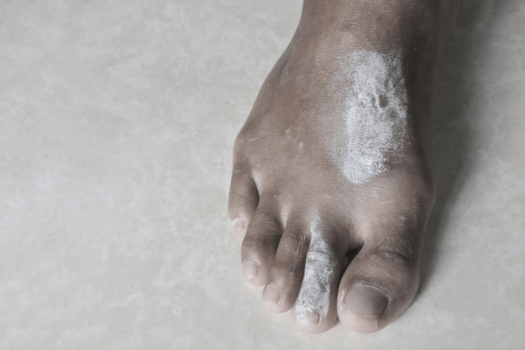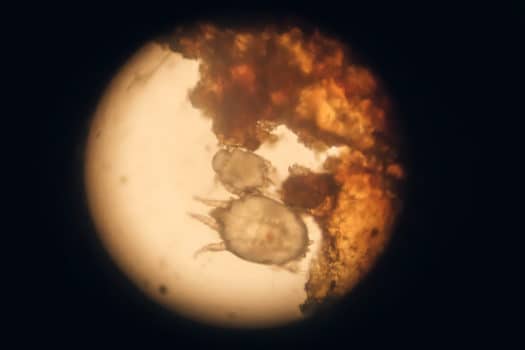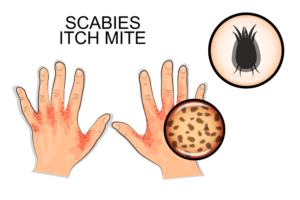WHAT IS SCABIES
Scabies is an infestation caused by a tiny parasite called “Sarcoptes scabiei” or the human itch mite; scabies mites is a microscopic parasite that can live on your skin for months if left untreated; the females burrow into the host skin to lay eggs and this after the female mate with a male on the surface of the skin; what causes a rash and intense itching due to the allergic reaction of the body; at first, the itching is minor, but it soon becomes torture for the host, so that he cannot sleep at night (Continuous scratching of the infected area can turn to a sore that becomes infected with time); The infestation is transmitted through direct skin to skin contact.
Whether you suspect that you have it, or that someone in your surroundings has it, keep reading, and you will find an answer to all your questions: what is scabies mites? Is it contagious? Etc…
WHAT DOES SCABIES LOOK LIKE
The scabies rash looks like a pimple or blister, pink, raised bumps with a transparent top full of fluid; you may also notice some lines or tiny red spots in the skin, which are the traces of the tunnels that the insect digs under the dermis to lay eggs. These mites are so tiny that it cannot be seen by the human eye; When viewed by a microscope, you can see that they have a round body and eight legs.
Find out more details about how scabies looks like on our scabies pictures page, to know if you have scabies or not.
WHAT IS CRUSTED NORWEGIAN SCABIES

Credit: shutterstock.com
SCABIES LIFE CYCLE
There are 4 stages in the life cycle of scabies, which generally does not exceed two months:
- In the first stage, the females lay up to 4 eggs under the skin.
- The second stage, after 4 days, the eggs hatch to become a larva.
- Third, this parasite takes the form of a nymph after four days approximately, under the skin of the host;
- And finally, it becomes adult scabies, the female mate with a male, and then borrows again under the skin to lay eggs and repeat the cycle. Each parasite may produce up to thirty eggs during her life cycle.
HOW LONG DOES SCABIES LAST?
Scabies mites can only survive for 72 hours without a human host, but once the parasite finds a human host it can live up to two months; the mites will burrow into the skin, and symptoms usually start three to six weeks after infestation.
IS SCABIES CONTAGIOUS?
Scabies is badly contagious, you may catch it from another person; still, it requires physical, direct skin to skin contact with an infected person; rarely, through sharing clothes and beds with an infected person.
The victim may not show any symptoms until fifteen days after the infection; the hosts can spread the disease in their surroundings if no treatment is taken to get rid of scabies. However, after using a cream-based treatment, the host becomes no longer contagious after 24 to 48 hours.
IS SCABIES A SEXUALLY TRANSMITTED DISEASE?
On the whole, most health organizations consider scabies as sexually transmitted infection STI; simply, because sex remains one of the most important causes of transmission. In spite of that, and as a correction of some misconceptions we have shown before, that scabies can spread through any direct skin to skin contact, not only through sex.
CAN SCABIES KILL YOU?
Scabies cannot kill a person if the proper medication is taken on time. Sometimes what leads to an uncontrollable state of the infestation is negligence, but when the medication is applied to the affected part of the body on time it can be controlled from spreading.





